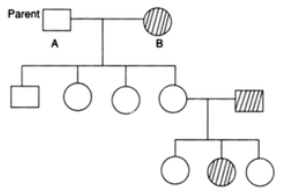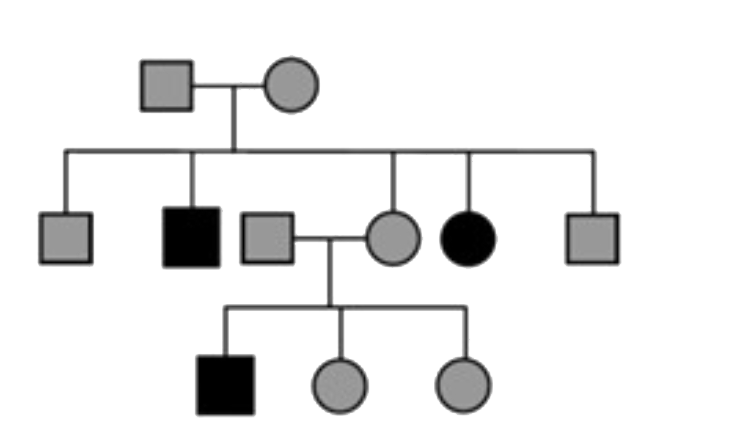If both the parents are carriers for thalassemia which is an autosomal recessive disorder what are the chances of pregnancy resulting in an affected child
No chance
The correct Answer is:B
To determine the chances of a pregnancy resulting in an affected child when both parents are carriers for thalassemia, we can follow these steps:
1. Understand the Genetic Background:
- Thalassemia is an autosomal recessive disorder. This means that an individual must inherit two copies of the recessive allele (small t) to express the disorder. If they inherit one normal allele (capital T) and one recessive allele (small t), they will be carriers but not affected.
2. Identify the Genotypes of the Parents:
- Since both parents are carriers, their genotypes can be represented as:
- Parent 1: Tt (heterozygous)
- Parent 2: Tt (heterozygous)
3. Determine Possible Gametes:
- Each parent can produce two types of gametes:
- Parent 1 can produce gametes: T (normal) and t (thalassemia)
- Parent 2 can produce gametes: T (normal) and t (thalassemia)
4. Create a Punnett Square:
- We can use a Punnett square to visualize the possible combinations of alleles from the parents:
| | T (from Parent 2) | t (from Parent 2) |
|-------|--------------------|--------------------|
| T (from Parent 1) | TT (normal) | Tt (carrier) |
| t (from Parent 1) | Tt (carrier) | tt (affected) |
5. Analyze the Offspring Genotypes:
- The possible genotypes of the offspring from the Punnett square are:
- TT: Normal (1 out of 4)
- Tt: Carrier (2 out of 4)
- tt: Affected (1 out of 4)
6. Calculate the Probability of an Affected Child:
- Out of the four possible combinations, only one combination results in an affected child (tt).
- Therefore, the probability of having an affected child is 1 out of 4, or 25%.
Final Answer:
The chances of a pregnancy resulting in an affected child (thalassemia) when both parents are carriers is 25%.
---
- Thalassemia is an autosomal recessive disorder. This means that an individual must inherit two copies of the recessive allele (small t) to express the disorder. If they inherit one normal allele (capital T) and one recessive allele (small t), they will be carriers but not affected.
- Since both parents are carriers, their genotypes can be represented as:
- Parent 1: Tt (heterozygous)
- Parent 2: Tt (heterozygous)
- Each parent can produce two types of gametes:
- Parent 1 can produce gametes: T (normal) and t (thalassemia)
- Parent 2 can produce gametes: T (normal) and t (thalassemia)
- We can use a Punnett square to visualize the possible combinations of alleles from the parents:
| | T (from Parent 2) | t (from Parent 2) |
|-------|--------------------|--------------------|
| T (from Parent 1) | TT (normal) | Tt (carrier) |
| t (from Parent 1) | Tt (carrier) | tt (affected) |
- The possible genotypes of the offspring from the Punnett square are:
- TT: Normal (1 out of 4)
- Tt: Carrier (2 out of 4)
- tt: Affected (1 out of 4)
- Out of the four possible combinations, only one combination results in an affected child (tt).
- Therefore, the probability of having an affected child is 1 out of 4, or 25%.
The chances of a pregnancy resulting in an affected child (thalassemia) when both parents are carriers is 25%.
Topper's Solved these Questions
- BOOK - AAKASH INSTITUTE ENGLISHCHAPTER - PRINCIPLES OF INHERITANCE AND VARIATIONEXERCISE - Assignment (SECTION-D) Assertion-Reason Type Questions20videos
PRINCIPLES OF INHERITANCE AND VARIATION
- BOOK - AAKASH INSTITUTE ENGLISHCHAPTER - PRINCIPLES OF INHERITANCE AND VARIATIONEXERCISE - Assignment (SECTION-B) Objective Type Questions35videos
PRINCIPLES OF INHERITANCE AND VARIATION
- BOOK - AAKASH INSTITUTE ENGLISHCHAPTER - PLANT KINGDOM EXERCISE - ASSIGNMENT SECTION -D (Assertion - Reason Type Questions)10videos
PLANT KINGDOM
- BOOK - AAKASH INSTITUTE ENGLISHCHAPTER - REPRODUCTION IN ORGANISMS EXERCISE - ASSIGNMENT SECTION-D ASSERTION - REASON TYPE QUESTION IN THE FOLLOWING QUESTIONS, A STATEMENT OF ASSERTION (A) IS FOLLOWED A STATEMENT OF REASON (R ).15videos
REPRODUCTION IN ORGANISMS
Similar Questions
If both parents are carriers for thalassemia, which is an autosomal recessive disorder, what are the chances of pregnant women resulting in an affected child?
View SolutionIf both parents are carriers for thalessemia, which is an autosomal recessive disorder, what are the chances for pregnancy resulting in an affected child?
View SolutionIf both parents are carriers for thalessemia, which is ai:, autosomal recessive disorder, what are the chan~e~ pregnancy resulting in an affected child?
View SolutionIf both the parents are carriers of autosomal r recessive disorder thalassemia , what are the chances of pregnancy resulting in an affected child
View SolutionWhich one of the following is an example of an autosomal recessive disorder?
View SolutionSickle-cell anaemia as well as thalassemia are autosomal recessive diseases.
What do the terms autosomal and recessive mean?View SolutionIf a mother and father both have one mutant gene for a disease with an autosomal dominant inheritance, what is their risk of having an affected child?
View SolutionGiven pedigree shows inheritance of autosomal recessive gene. What is the genotype of given parents ?
 View Solution
View SolutionGiven pedigree belongs to autosomal recessive disorder , which of the following represents parental genotypes correctly ?
 View Solution
View SolutionOf both normal parents, the chance of a male child becoming colour blind are
View Solution

